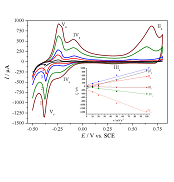
Electrochemical and nanogravimetric studies of iron phthalocyanine microparticles immobilized on gold in acidic and neutral media
The paper authored by
Á. Nemes and
G. Inzelt
is published in Journal of Solid State Electrochemistry (2014, vol. 18, pp. 3327–3337).
Abstract:
An electrochemical quartz crystal nanobalance has been used to study the redox behavior of iron phthalocyanine (FePc) microparticles attached to gold in contact with acidic and neutral aqueous solutions at different pH values in the absence and presence of oxygen, respectively. Five redox transformations have been detected: one has been assigned to the Fe2+/Fe3+ redox process, while four of those have been assigned to the oxidation and reduction of the Pc ring; however, the reduction of Fe2+ and the reoxidation of Fe+ cannot be entirely excluded at potentials more negative than ca. -0.4 V vs. saturated calomel electrode (SCE). The redox processes are accompanied with significant mass changes which are related to the sorption and desorption of counterions and solvent molecules. An extensive solvent swelling occurs. The relatively slow motion of solvent molecules introduces a substantial scan rate dependence regarding the mass change during potential cycling. Due to the participation of H+ ions, the processes related to the oxidation and reduction of the Pc ring show pH dependence. Simultaneous with the charge transfer processes, solid-solid phase transitions can be assumed, especially in the case of the redox transformations occurring at most cathodic potentials. The mass change that can be detected in the presence of oxygen indicates a bonding of oxygen to FePc. During a cathodic voltammetric scan, the reduction of oxygen (ORR) starts when the central iron (III) ion of FePc is converted to Fe(II) during reduction. It follows that the electrocatalytic efficiency of FePc, which is comparable with that of Pt in acid and neutral solutions, cannot be expected at even lower overpotentials because the redox transformation of the central Fe ion of FePc determines the rate of the ORR.
